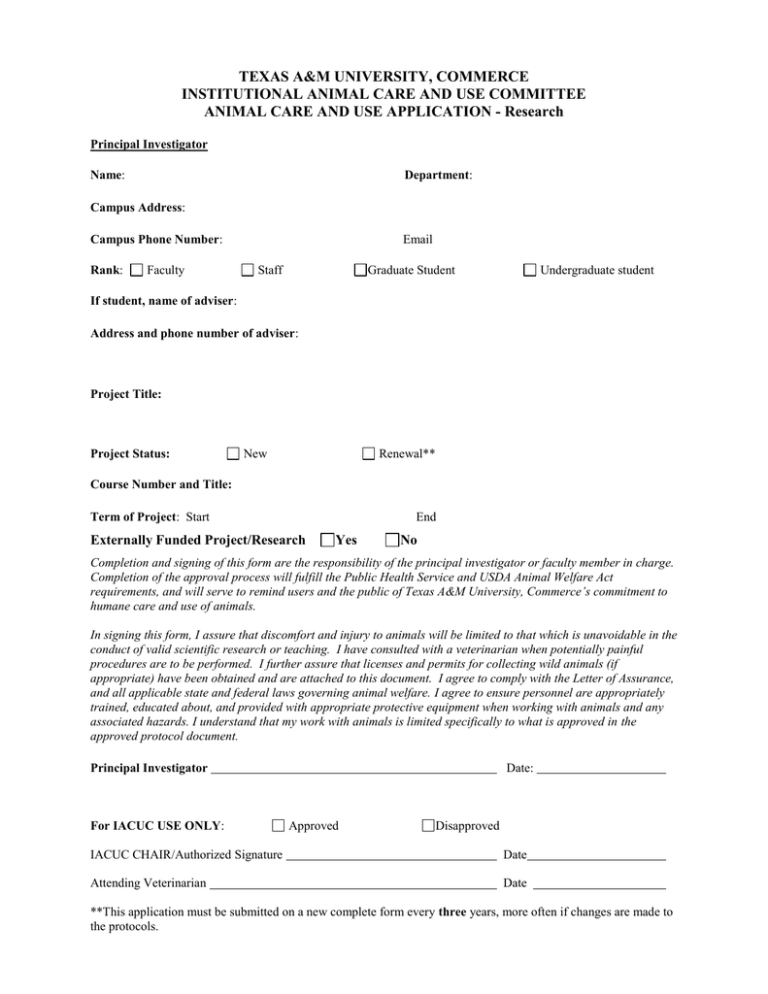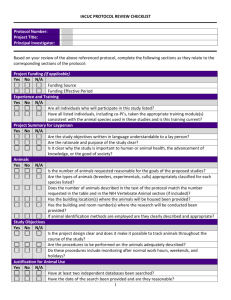Research Protocol Form
advertisement

TEXAS A&M UNIVERSITY, COMMERCE INSTITUTIONAL ANIMAL CARE AND USE COMMITTEE ANIMAL CARE AND USE APPLICATION - Research Principal Investigator Name: Department: Campus Address: Campus Phone Number: Rank: Faculty Email Staff Graduate Student Undergraduate student If student, name of adviser: Address and phone number of adviser: Project Title: Project Status: New Renewal** Course Number and Title: Term of Project: Start End Externally Funded Project/Research Yes No Completion and signing of this form are the responsibility of the principal investigator or faculty member in charge. Completion of the approval process will fulfill the Public Health Service and USDA Animal Welfare Act requirements, and will serve to remind users and the public of Texas A&M University, Commerce’s commitment to humane care and use of animals. In signing this form, I assure that discomfort and injury to animals will be limited to that which is unavoidable in the conduct of valid scientific research or teaching. I have consulted with a veterinarian when potentially painful procedures are to be performed. I further assure that licenses and permits for collecting wild animals (if appropriate) have been obtained and are attached to this document. I agree to comply with the Letter of Assurance, and all applicable state and federal laws governing animal welfare. I agree to ensure personnel are appropriately trained, educated about, and provided with appropriate protective equipment when working with animals and any associated hazards. I understand that my work with animals is limited specifically to what is approved in the approved protocol document. Principal Investigator For IACUC USE ONLY: Date: Approved Disapproved IACUC CHAIR/Authorized Signature Date Attending Veterinarian Date **This application must be submitted on a new complete form every three years, more often if changes are made to the protocols. General Purpose of Project (check all that apply) Research Project Pilot Project Student Special Project Behavioral Basic Procedure(s) (check all that apply) Blood/Tissue collection Surgical Lesion Pharmacological QUALIFICATIONS/TRAINING/EXPERIENCE DOCUMENTATION: Provide the names of all associated co-investigators, students and technicians who will have direct animal contact. Specify those persons performing anesthesia and surgery. For each person, briefly state their experience/qualifications to perform the procedures described within this application, or how training will be obtained if needed. PURPOSE OF PROPOSED RESEARCH: Please provide a brief lay-oriented statement outlining the purpose and scientific merit of the research project. This explanation should include your project’s relevance to human or animal health and/or the advancement of knowledge. Include the rationale for the choice of species and number of animals used. RATIONALE AND BACKGROUND: Describe the goal of the project, the hypothesis to be tested and a brief summary of the experimental methods. ASSURANCE THAT PROPOSED WORK DOES NOT UNNECESSARILY DUPLICATE PREVIOUS RESEARCH: The Animal Welfare Act requires that the principal investigator has provided assurance that the research activities do not unnecessarily duplicate previous experiments. Provide a description of the methods and sources used to determine that the proposed research does not unnecessarily duplicate previous experiment. Has a thorough literature search been done? Yes No Provide two sources consulted (e.g. Science Direct, Medline etc.) ANIMAL HUSBANDRY AND JUSTIFICATION OF USE: Species Total for Project Source of Animals Housing LocationUse Area If wild animals are used, describe how they will be trapped and types of traps used. Describe the characteristic of the animals that satisfy their use in this study and how the number of animals needed was determined. Are all husbandry and handling practice standard (routinely performed in this facility)? Yes No If no, describe all deviations from standard procedures and practices. e.g. prolonged restraint is not considered a standard practice and must be justified. Will animals be kept longer than 12 hours in any area other than the main housing facility? Yes No N/A If yes, indicate the location (building and room #), number of animals and explain why the animals must be kept outside the main facility. Disposition of Animals: Euthanasia Return to Colony Return to wild Transfer to different project entitled: Other (explain): Check the method that will be used for euthanasia. Note that euthanized animals may not be made available for human consumption. A. Inhalant agents (please provide specific agent and route of administration) B. Injectable agents (please provide specific drug, dosage and route of administration) C. Physical Methods Cervical dislocation (Animals < 200 grams) Decapitation with guillotine Will animals be sedated/anesthetized during physical methods? Yes No If no, provide scientific justification for performing this procedure without sedation/anesthesia. D. Exsanguination (method to be used ONLY in anesthetized animals) E. Other Method (describe) Experimental Manipulations: Yes answers to the following questions require additional sections to be completed. Yes No Situation Will surgery be performed? If yes, complete Section A. Will anesthetics be administered? If yes, complete Section B. Will animals have a serious or experimentally-induced disease, perceive pain and discomfort, or be subjected to prolonged restraint or aversive stimuli? If yes, complete Section C. Does this project require the use of radioactive materials, or biohazardous agents in surviving, live animals? If yes to either, complete Section D. SECTION A: SURGERY Surgery is defined as a major operative procedure that exposes a body cavity or produces a substantial impairment of physical or physiologic function. Multiple survival surgeries on a single animal are discouraged unless they can be scientifically justified. All survival surgery must be performed using aseptic procedures, including surgical gloves, masks, sterile instruments and aseptic techniques. Non-rodent mammalian survival surgery must be performed in an operating room used only for surgery. Type of surgery will be: Survival Non survival Location where surgery will be performed: Describe the surgical procedures: Include aseptic preparation of the operative site, location and size of incisions, size and placement of catheters or devices that will be implanted, suture types used, and estimated time to complete the procedure. For acute procedures, include operative site preparation, description of procedures to be performed and estimated duration of the experiment. Will multiple survival surgeries be performed on any one animal? Yes No If yes, provide scientific justification for performing these procedures. Describe postoperative care including how often animals will be observed and all drugs to be administered. SECTION B: ANESTHESIA Preoperative regimen: Include length of withholding of food and/or water and drugs administered. Anesthetic regimen: List all pre-anesthetic, induction, maintenance and muscle relaxant drugs that will be used. Include dosages and routes of administration. Analgesic drugs: Provide drug names, dosages, route and frequency. If analgesic drugs cannot be administered, provide scientific justification for withholding them. Describe the procedures and methods that will be used to indicate that adequate depth of anesthesia is being maintained. SECTION C: Animals will have serious natural or experimentally induced condition, will perceive discomfort, or be subjected to periods of restrain or aversive stimuli. Procedures that would be expected to cause pain or distress in a human should also be considered painful for animals. Prolonged restraint means the animal is kept confined or immobilized for time periods in excess of those required for administration of treatments or routine handling procedures. Consideration of alternatives: What consideration have you given to refining procedures to be less painful; to using other non-vertebrate species; to using fewer numbers of animals; or to non-animal alternatives? Will the animal’s death be used as an experimental endpoint? Yes No If not, list the specific criteria for euthanasia of sick animals. If the animal cannot be euthanized, please provide a justification. If the animal will have a serious natural or experimentally induced condition, answer the following: What condition(s) will the animals have? How will progression of the condition be monitored? What measure(s) will be taken to alleviate or minimize pain or distress? Check appropriate space(s) below and provide details under comments. Injection of hazardous/toxic substance into a living animal Immunization protocol Prolonged restraint Food/water deprivation Abnormal environment (temperature, humidity, light/dark) Hybridoma protocols Aversive stimuli Comments: SECTION D: Hazardous substances that will be injected into living animals Check all that apply: Infectious agent Toxic chemical Radioisotope Carcinogen Recombinant DNA Transplantable cell line Other (list) Describe agent, amount, and route of administration: List specific safety precautions and procedures for handling animals: Has the necessary approval been obtained from: Radiation Safety Officer Yes No N/A Biosafety Officer Yes No N/A




